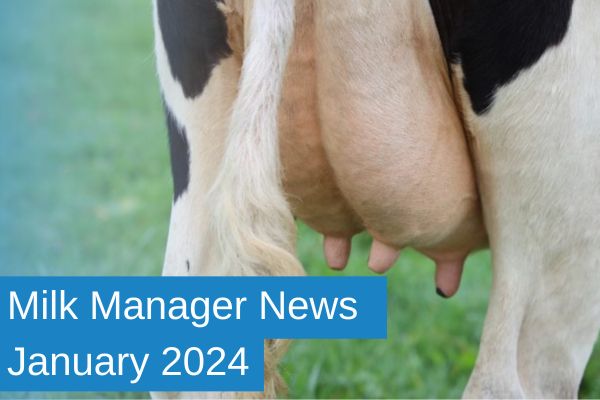MMN January 2024 – Colostrum Quality from Heifers
12 January 2024It is often said that the quality of colostrum (in terms of immunoglobin content or IgG) from heifers is not as good as that from cows. Older cows are likely to have had exposure to a wider range of pathogens than heifers and therefore produce better quality colostrum. While some heifers can still produce good quality colostrum it generally tends to be of a lower volume, with a lower concentration of immunoglobulins. Their colostrum quality can be improved by ensuring they join the dry cow group at least four weeks prior to calving to increase their exposure to pathogens that may be present in the adult herd.
Quality cannot be determined by eye, as immunoglobulin content is unrelated to the colour and thickness of colostrum. In addition, the volume of colostrum produced immediately after calving cannot reliably be used to assess quality, although there can be a dilution effect with higher yielding animals producing poorer quality colostrum. The quality is likely to be poor if more than 8.5 litres are obtained immediately post-calving.
A US study based on 1,972 heifer calves from 104 dairy farms confirmed the higher quality of colostrum in older cows (on average 84.7g IgG/L). However, there was no difference in IgG content between 1st and 2nd lactation animals (72.3g and 72.0g IgG/L respectively). Interestingly, calves from 1st lactation dams had significantly higher serum levels (25.7g IgG/L) compared to calves out of 2nd and 3rd lactation cows (24.1 and 22.4g IgG/L respectively), despite the heifers producing lower quality colostrum. This was thought to be due to 1st lactation dams producing lower birth weight calves.
Given that heifers generally produce a lower volume of colostrum and show less leaking of colostrum before calving compared to older cows, the level of IgG in their colostrum may not always be that much lower.
Regardless of whether colostrum is from cows or heifers one of the biggest influences on colostrum quality is the time after calving when it is collected. Around 5 weeks before calving, immunoglobulins start to be transferred from blood to colostrum and is maximal in the final two weeks pre-calving. Production of colostrum stops immediately once the calf is born. Therefore, the dam starts to produce milk after calving and colostrum will start to be diluted. The other well-known factor affecting how well calves gain immunity will be how quickly they receive colostrum after birth.
One study showed that the quality of colostrum was diluted by 3.7% on average every hour from calving to milking. Therefore if the dam is milked 8 hours after calving, the quality is reduced by 29.6%. This means that the IgG content could fall from its target of 50g/litre to 35.2g/litre by 8 hours. This is one of the risks in a twice a day milking system if colostrum is taken off the calved animal at the next milking time and there is a significant period of time between calving and the next milking. If colostrum quality is lower than 22% on the brix scale (or not in the green zone when testing with a colostrometer), it can still be valuable as a second or third feed depending on the farm’s milk feeding regime.
Note that contamination of colostrum by bacteria and other pathogens can reduce the absorption of colostral immunoglobulins in the gut. This is down to pathogens speeding up the process of gut closure, reducing the ability of the calf to absorb immunoglobulins into the bloodstream. It is recommended that colostrum should have a total bacteria count of less than 100,000 cfu/mL and a total coliform count of less than 10,000 cfu/mL. If colostrum is left sitting in a bucket for more than 6 hours before being fed, there is an increased risk of exceeding these hygiene thresholds.
In conclusion, heifer colostrum may be of acceptable quality and so it shouldn’t automatically be discarded. Make sure you test all colostrum from cows and heifers and only feed the best colostrum from animals of any parity. In addition, if the first milking is of a high volume, again test it because if it was collected quickly after calving, it could still be of acceptable quality.
Lorna MacPherson, lorna.macpherson@sac.co.uk; 07760 990901
Sign up to the FAS newsletter
Receive updates on news, events and publications from Scotland’s Farm Advisory Service

